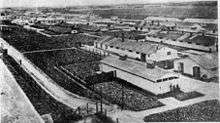Thalerhof internment camp

Thalerhof (also trasliterated as Talerhof from Cyrillic-based East Slavic texts) was an concentration camp created by the Austro-Hungarian authorities during World War I, in a valley in foothills of the Alps, near Graz, the main city of the province of Styria.
The Austro-Hungarian authorities imprisoned Carpatho-Rusyns and Ukrainian Russophiles, as well as other Ukrainians and Lemkos from Galicia and Bukovina, considered unreliable during wartime. The first group of prisoners was interned in Talerhof on September 4, 1914. Another internment camp for Rusophiles was the Terezín fortress (German: Theresienstadt), now in the Czech Republic.
A Ukrainian historian argues that these people were punished for their loyalty to the Russian language and culture, saying that the people who had renounced the Russian language and identified themselves as Ukrainians were released from the camp. [1] Over twenty thousand people were arrested and placed in the Austrian internment camp in Thalerhof.[2]
Until the winter 1915, there were no barracks in Thalerhof. Prisoners slept on the ground in the open-air during rain and frost. According to U.S. Congressman Medill McCormick, prisoners were beaten and tortured.[3] On November 9, 1914 official report of field marshal Schleer said there were 5,700 Carpatho-Rusyns, Lemkos, and Ukrainians in Talerhof. In all, 20 thousand people were prisoners of Talerhof from September 4, 1914 to May 10, 1917. The camp was closed by Emperor Charles I of Austria, after the first 6 months of his reign.[4]
In the first eighteen months of its existence, three thousand prisoners of Thalerhof died, including the Orthodox saint Maxim Sandovich, who was martyred here (beatified August 29, 1996 by the Russian Orthodox Church Outside Russia).
The Graz Airport is located at the camp site now.
A mass grave of Thalerhof internees is located at Feldkirchen bei Graz.
People interned in Thalerhof
- Jaroslav Kacmarcyk
- Maxim Sandovich
- Metodyj Trochanovskij
- Encyclopedia of Rusyn History and Culture lists the following persons: priests (Havryil Hnatyshak, Teofil’ Kachmarchyk, Dymytrii Khyliak, Vasylii Kuryllo, Mykolai Malyniak, Vasylii Mastsiukh, Tyt Myshkovskii, Ioann Polianskii, Olympii Polianskii, Roman Pryslopskii), lawyers (Iaroslav Kachmarchyk, Teofil’ Kuryllo) and cultural activists (Nikolai Hromosiak, Dymytrii Kachor, Simeon Pysh, Metodii Trokhanovskii, Dymytrii Vyslotskii).[4]
See also
| Wikimedia Commons has media related to Thalerhof internment camp. |
References
- ↑ Vavrik, Vasili Romanovich (2001). ТЕРЕЗИН И ТАЛЕРГОФ. К 50-летней годовщине трагедии Галицко-Русского народа (in Russian). Moscow: Soft-izdat. Retrieved 2009-06-21. , originally published in 1966 by Archpriest R. N.Samelo (протоиерей Р. Н. Самело), New York
- ↑ "The Story of Talerhof - We Should Not Forget" (reprint). Karpatska Rus'. Yonkers, NY. LXVII (16). 5 August 1994. Retrieved 24 May 2010.
- ↑ "Terrorism in Bohemia.; Medill McCormick Gets Details of Austrian Cruelty There" (PDF). New York Times (December 16). 1917. Retrieved 2008-09-28.
- 1 2 Horbal, Bogdan. "Talerhof (German: Thalerhof)". Retrieved 2008-01-20. World Academy of Carpatho-Rusyn Culture website, citing f Encyclopedia of Rusyn History and Culture